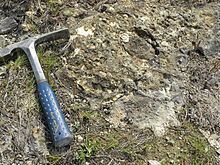Named for Ripley Underlies Prairie Bluff Formation | Overlies Demopolis Chalk Formation | |
 | ||
Sub-units Cusseta Sand Member, McNairy Sand Member Thickness 40 m (130 ft) to 175 m (574 ft) Regions | ||
The Ripley Formation is a geological formation in North America found in the U.S. states of Alabama, Georgia, Mississippi, Missouri, and Tennessee. The lithology is quite consistent throughout the layer. It consists mainly of glauconitic sandstone. It was formed by sediments deposited during the Maastrichtian stage of the Late Cretaceous. It is a unit of the Selma Group and consists of the Cusseta Sand Member, McNairy Sand Member and an unnamed lower member. It has not been extensively studied by vertebrate paleontologists, due to a lack of accessible exposures. However, fossils have been unearthed including crocodile, hadrosaur, nodosaur, tyrannosaur, ornithomimid, dromaeosaur,and mosasaur remains have been recovered from the Ripley Formation.
